
Welcome, class.
Due to a variety of reasons stemming from trending, blatant cash-ins, and all-too-frequent voids of creativity, the horror genre is particularly prone to repetition. Yet individuals such as myself (and quite likely you) crave the fruits of the horror tree all the same. What others would call clichés, we call conventions. A cliché is something that has become trite with overuse; something we are tired of seeing. A convention is a customary practice, a rule. To us, horror films are like episodes of a favorite TV show. We tune in week after week specifically to bask in these familiar tropes, traditions, and archetypes. Here in Horror 101 we shall turn an academic eye on this vast world of horror movie conventions.
So come journey with me into the haunted recesses of one of cinema’s oldest genres. Don’t be chickenshit. No one has disappeared in here for years. Plus, I found this dusty old Ouija board we can get drunk and play with…
(Lesson 8 of 9)
First off I’d like to apologize for the delay in getting this lesson up. I had been waiting for the CHUD revamp to go through, and then a back up of other work jammed the works even further. Anyway, excuses, excuses. Class has resumed…
Last time, if you will recall, we officially rounded out our model medieval horror story, adding a dragon (Villain) to wreak bloody trouble for our knight (the Hero), his maiden (the Love Interest), the wizard (the Guy Who Knows Things), the jester (the Jokester), and a host of eatable villagers (the Public Victim Pool). Given that our knight is presumably predisposed to bold bravery, we are going to be dealing with a Proactive Hero. If you have been sticking with your studies you will hopefully remember that there are two types of Proactive Heroes: the Ass Kicking Hero and the Detective Hero. It is unlikely that we would want to pit our knight against our dragon repeatedly – we do not want him to seem ineffectual, after all – so structurally we will be telling a Detective Hero story. Our knight will be journeying to find the dragon, likely encountering the beast only once (if at all) prior to Act III. This allows our knight to stay maximally badass.
Of course, the downside is that his badassness is going to waste without a dragon to fight every ten minutes. We could toss in some sub-Villains to fight: a bog hag, a troll, a band of sinister thieves. The problem with this move is that it always distracts from the basic core of the film – here it is man vs dragon. Would Jaws (1975) have had the same impact if Chief Brody (Roy Scheider) had also fought and killed a rogue bear and a rogue tiger before finally setting out slay the rogue shark?
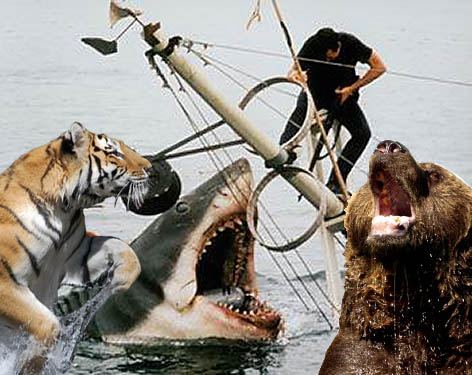
So what do we do if we want a Proactive Hero then? Simple. We multiply! Instead of one humungous dragon, we could have scores of smaller dragons. We could have a Horde.
There is not a minimum number of Villains required to form a Horde. In fact, a key component to a Horde is “size ambiguity.” Generally speaking, Hordes are comprised of an indeterminate number of Villains. At the end of the day there might only be twenty members in a Horde, but there should be a sense that we never see each individual member on screen. If we are given an exact number of Villains, the number should be quite large.
Villain groups with an exact number are usually Packs (or Clans, if they are human, as we learned in the Slasher lesson). Packs generally have members with distinctive personalities, physical features, or roles within the Pack – like the family unit from Feast (2005) – that allow our Hero to easily calculate the Pack’s total number. This gives the Hero a sense of clarity in plotting his/her course (1 down, 2 to go, or what have you). Hordes may have a shared goal – such as eating all humans – but they operate fluidly and organically. This tends to deprive the Hero of that coherency a Pack provides. Though, sometimes, shoddy filmmaking can obscure that coherency all the same. Neon Maniacs (1986), for example, presents what is supposed to be a fixed Pack of Villains, but does so in such a confusing way that it is almost as though there are an unlimited Horde of Maniacs.
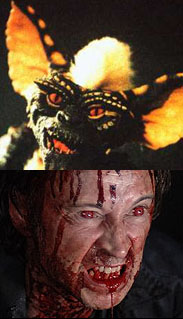 Horde movies come with a certain loss in dramatics – that basic Melvillian nemesis bond you get from focusing attention on a single Villain. Many Horde movies try to overcome this deficit by creating a Figurehead to falsely create the nemesisry bond that a 1:1 horror movie has. A Figurehead is different than the Queen of a Hive (more on that below), as it isn’t necessarily in command of a Horde. In fact, it might literally have no control over its comrades whatsoever. It is simply given inflated screen-time to make the climax of the film more satisfying, to give our Hero a symbolic final victory over a foe that serves to represent the whole. The character works best when it does have some actual power within the Horde, like Stripe in Gremlins (1984). Less effective is when the Figurehead has no commanding status within the Horde, but the film blows the individual up to a Stripe-like level of importance, like Robert Carlyle’s super-zombie from 28 Weeks Later (2007). In Hordes with members who look mostly identical, the Figurehead generally has a physical characteristic that sets it apart, like “stumpy” the Graboid with the missing mouth-tentacle in Tremors (1990), whose only true significance is that it is the first and last Graboid Kevin Bacon encounters.
Horde movies come with a certain loss in dramatics – that basic Melvillian nemesis bond you get from focusing attention on a single Villain. Many Horde movies try to overcome this deficit by creating a Figurehead to falsely create the nemesisry bond that a 1:1 horror movie has. A Figurehead is different than the Queen of a Hive (more on that below), as it isn’t necessarily in command of a Horde. In fact, it might literally have no control over its comrades whatsoever. It is simply given inflated screen-time to make the climax of the film more satisfying, to give our Hero a symbolic final victory over a foe that serves to represent the whole. The character works best when it does have some actual power within the Horde, like Stripe in Gremlins (1984). Less effective is when the Figurehead has no commanding status within the Horde, but the film blows the individual up to a Stripe-like level of importance, like Robert Carlyle’s super-zombie from 28 Weeks Later (2007). In Hordes with members who look mostly identical, the Figurehead generally has a physical characteristic that sets it apart, like “stumpy” the Graboid with the missing mouth-tentacle in Tremors (1990), whose only true significance is that it is the first and last Graboid Kevin Bacon encounters.
While a Horde film deprives our Hero of simplicity of purpose, it does have something to offer – action. Common Slasher films are generally structured like a Shakespearen farce, with the confluence of events shielding the Hero from realizing someone is killing all of his/her friends until nearly the end of the film. Suspense? Hopefully. Action for the hero? Not so much. If we change our single dragon into a Horde of smaller dragons, our Ass Kicking Hero knight can slay to his heart’s content.
Hordes can be made up of anything, from bees to aliens to zombies to alien zombie bees. There are four basic types of Hordes:
• The Evil Populace
• The Hive
• Crazed Animals
• The Infected
The Evil Populace
As we learned in the previous lesson, if a car-full of lost travelers finds themselves besieged by a small group of murderous humans in the middle of no where, then we’re dealing with a Clan. But what if those lost travelers find themselves besieged by an entire town of murderous humans? Evil Populace films are in a similar vein as Stumbled On Clan films, only instead of playing off of big city folks’ innate prejudices against country bumpkins, they play off innate prejudices against small town communities. These can be simple Stumbled On films, like Children of the Corn (1984), or maybe there is a sinister purpose at work, maybe our Hero has actually been lured intentionally to the community, like The Wicker Man (1973).
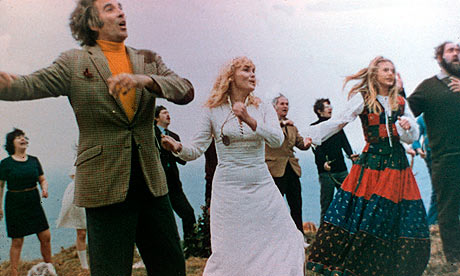
Though the EP is generally made up of humans, that is not a prerequisite. The community in Sundown: The Vampire in Retreat (1990) is made up of vampires. But that film is also a silly comedy. Usually it is hard to take a horror film seriously if we’re dealing with an entire town of secret monsters.
EP films generally do not require a Figurehead. Because we are dealing with human beings, this allows the film to have a wide variety of supporting Villains amongst the overall Horde. Though, often, there is still a premier Villain who gets extra attention and might be considered a Figurehead, like Lord Summerisle (Christopher Lee) in The Wicker Man.
The Hive
We could have a film that on the surface has all the trappings of an EP Horde – lost road-trippers stop in a town full of evil weirdos – but then midway through the film we get a twist: the entire town is being mind-controlled by some sinister being! This would be a Hive. There are two subsections to a Hive film, determined by whether the Hive has a Brain or a Queen.
If we were dealing with a case of mind-control, than this Hive would have a Brain – the central system of which the individual members of the Hive are merely an extension. And like with any complex living system, killing the Brain kills the rest of the body. These types of Hive films end up with as much of a 1:1 nemesisry as a Horde film can really have, as the Hero must destroy this one character (or thing) to achieve victory. Grant Grant (Michael Rooker) in Slither (2006) is a good example of a Brain.
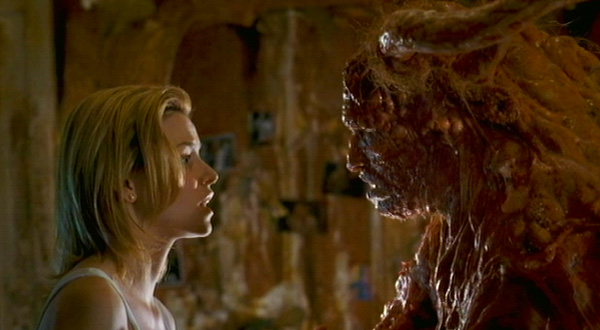
A Queen doesn’t need to be female, but following the classic insect hive model, “Queen” seems the most accurate term. A Queen may rule its/his/her Horde, but it is not directly controlling the members. Killing a Queen usually just prevents more members from being added to the Horde; the Horde itself still needs to be dealt with. Often the existence of the Queen is a surprise to our Hero, like the Queen Alien in Aliens (1986). A rare case where killing the Queen would in fact eradicate the Horde, would be a vampire Horde film that follows the mythology that killing the “head vampire” will free all those he/she infected. But I am hard pressed to think of an example of a Horde film that actually does this.
There are of course movies that buck the Brain/Queen trend, like The Ruins (2008), which features a seemingly endless number of carnivorous plant vines. Technically we know that these vines are all connected to a single Hive mind, but we’re never actually shown a Brain or Queen. Though our Hero also fails to defeat the vines, so this is somewhat moot. Either way, such films are exceptions that prove the rule.
Crazed Animals
The first Earth Day was held in 1970. It was the culmination of a new awareness of humanity’s effect on the environment, spurred on by all those hippies. With this new sense of responsibility inevitably came a horrible paranoia that it was all too late for humans, that we’d already fucked shit up beyond repair. It is this sort of area that awesome horror movies come from. Killer animals had been around for a while, but they were usually just a front for nuclear paranoia, and featured gigantic super animals, like the monstrous radioactive ants in Them! (1954). It wasn’t until the 70’s that killer animals came into full force. Nature was no longer something man had total control over. Now we could be afraid of it. Certainly the rise in killer animal films was in no small part helped by the immense popularity of Jaws, but we’re concerning ourselves here with killer animals, plural, or Crazed Animals, if you will.
Seemingly every species of animal was used in a Crazed Animal film in the 70’s – be it something genuinely spooky like killer bees out to get Michael Caine in The Swarm (1978) or tarantulas after William Shatner in Kingdom of the Spiders (1977), to something a little less inherently scary but still creepy, like killer worms in Squirm (1976), to something as absurd as an island of creatures that can only kill you if you fall down and don’t move for several minutes, like Frogs (1972). Then there is Day of the Animals (1977), which features an entire mountain where the depletion of Earth’s ozone layer has caused all the animals above the altitude of 5000 feet to go batshit homicidal.
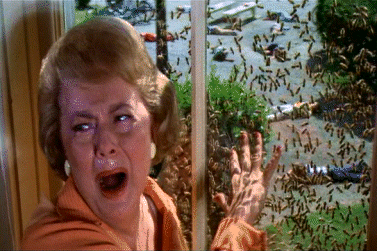
Crazed Animal movies interestingly wag the idea that, as Yoda might phrase it, impetus a Monster does not make. In most of these movies we are informed by the Guy Who Knows Things that the animals have become crazed because of something bad we humans did (here is the post-Earth Day paranoia). So in a way, we’re the Villain here. Karmically, we shouldn’t even be fighting back. Realistically, if the fact that I don’t recycle plastic bags causes hundreds of adorable puppies to try and eat me, I’m going to be killing adorable puppies left and right. Though that victory isn’t going to make me the most sympathetic Hero. That’s why a good portion of Crazed Animal movies make the wise decision to have the animal problem caused by the ever useful, all-purpose baddie, secret government/military testing! That way our Heroes can be 100% blameless and can concentrate, guilt free, on killing all those adorable puppies.
The Infected
Though Crazed Animals could certainly have become crazed through some manner of infection, for our purposes here the Infected are humans, or at least they originally were, before succumbing to the villainous Infection. What the Infection is, where it came from, how it spreads, what its manifestation is – this can vary wildly. The only key attribute is that it spreads somehow, converting innocent humans into villainous members of the Horde. So Infected films have a double-wammy of conflict: not only does the Hero have to fight off the members of the Horde, he/she must also avoid getting infected. When you’re fighting a swarm of killer bees, you don’t need to worry that you’ll be stung and then become a killer bee yourself. These films often tap into assimilation fears, and paranoia involving our own human frailty to illness.
The bulk of Infected Hordes these days are made up of zombies. Zombies I think work the best because they spread their Infection through biting. It is primal, and thus more unsettling. Vampires are sometimes used in the same way, like From Dusk Til Dawn (1996), though Vampire Horde films are also ignoring a lot of what makes vampire movies appealing, and is thus a smaller and weaker vampire subgenre (vampirism becomes a bit less interesting when its dangers are boiled solely down to avoiding being eaten or infected during a battle scenario). But the spreading of the Infection can be very different from this classic zombie-bite approach.
Sometimes what I am calling an “Infection” isn’t really like an Infection at all. In Invasion of the Body Snatchers (1956, 1978, etc) the Infection is spread through pods placed next to a sleeping individual. Shivers (1975) features slug-like parasites that “infect” the members of the Horde. The Crazies (1973, 2010) concerns tainted water that drives its drinkers to become homicidal maniacs, so in this instance – even though our Hero must be worried about getting infected – the members of the Horde are not capable of personally spreading the Infection, nor are they trying to. And Aliens is dually effective, because while it is more overtly a Hive film, the face-huggers/chest-bursters give it an added element of an Infected film too.
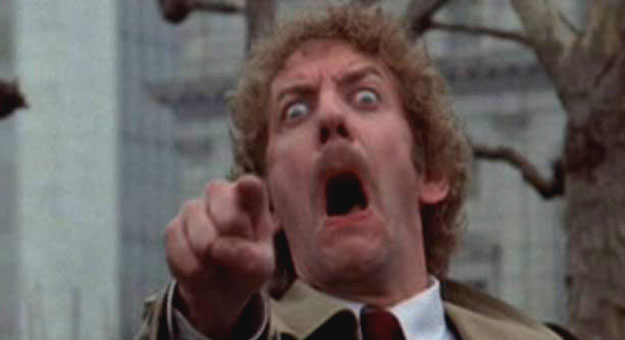
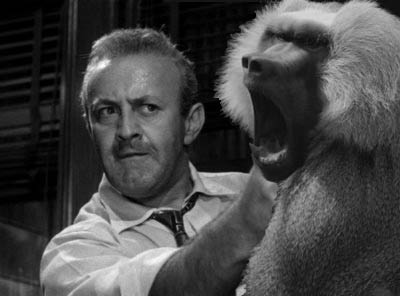
Our Hive Baboon Holocaust came out in 1984. It stars Dee Wallace as a children’s books author who is married to a scientist (William Atherton) working at a military facility trying to train an army of baboons for war purposes. Atherton is using an experimental machine intended to give a human officer the power of mental suggestion over the baboons. Atherton is a real asshole, and he and Wallace’s marriage is on the skids. This doesn’t stop Atherton from becoming obsessively jealous of Wallace’s friendly relationship with the artist who draws the pictures for her books (Treat Williams). When the government plans to shut down his project, Atherton snaps, hooking himself up to the baboon mind-control machine. Now he has an army of vicious baboons to do his bidding. After taking down the military facility, his next stop is teach Wallace and Williams a lesson. Only once Wallace and Williams kill Atherton, the Brain of the baboon Hive, will they be safe.
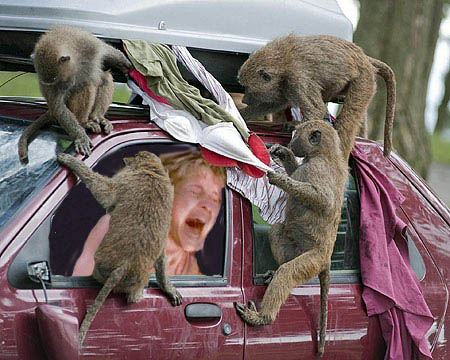
An Infected Baboon Holocaust really makes no sense, but here we go anyway! Released in 2002, the film stars Molly Sims as a college student who picks the wrong place for Spring Break when she and her friends (played by a host of unrecognizable actors) unwittingly start partying at a lake next to – what else? – a secret government lab performing tests on baboons. The nature of these tests? To harness the awesome power of baboons (which have been known to fight off leopard attacks) and cross their DNA with that of a human soldier. Of course, the experiment goes haywire and the baboons escape after killing all the scientists (featuring Lance Henriksen slumming it for a payday as the lead scientist). Now the baboons are hungry for meat, and worse yet, if you happen to survive one of their bites, your DNA will mutate and you’ll become a freaky baboon-human hybrid! Only the bikini-top clad Sims can stop them now.
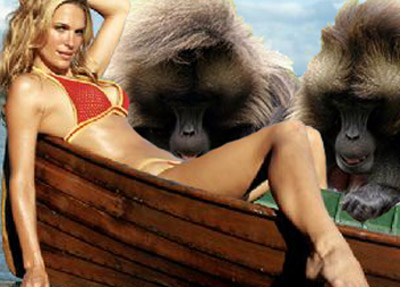
Well, looks like class is over. Join me next time for this semester’s final lesson!
The Solo Hero
The Couple
The Stragglers
The Guy Who Knows Things
The Jokester
The Victim Pool